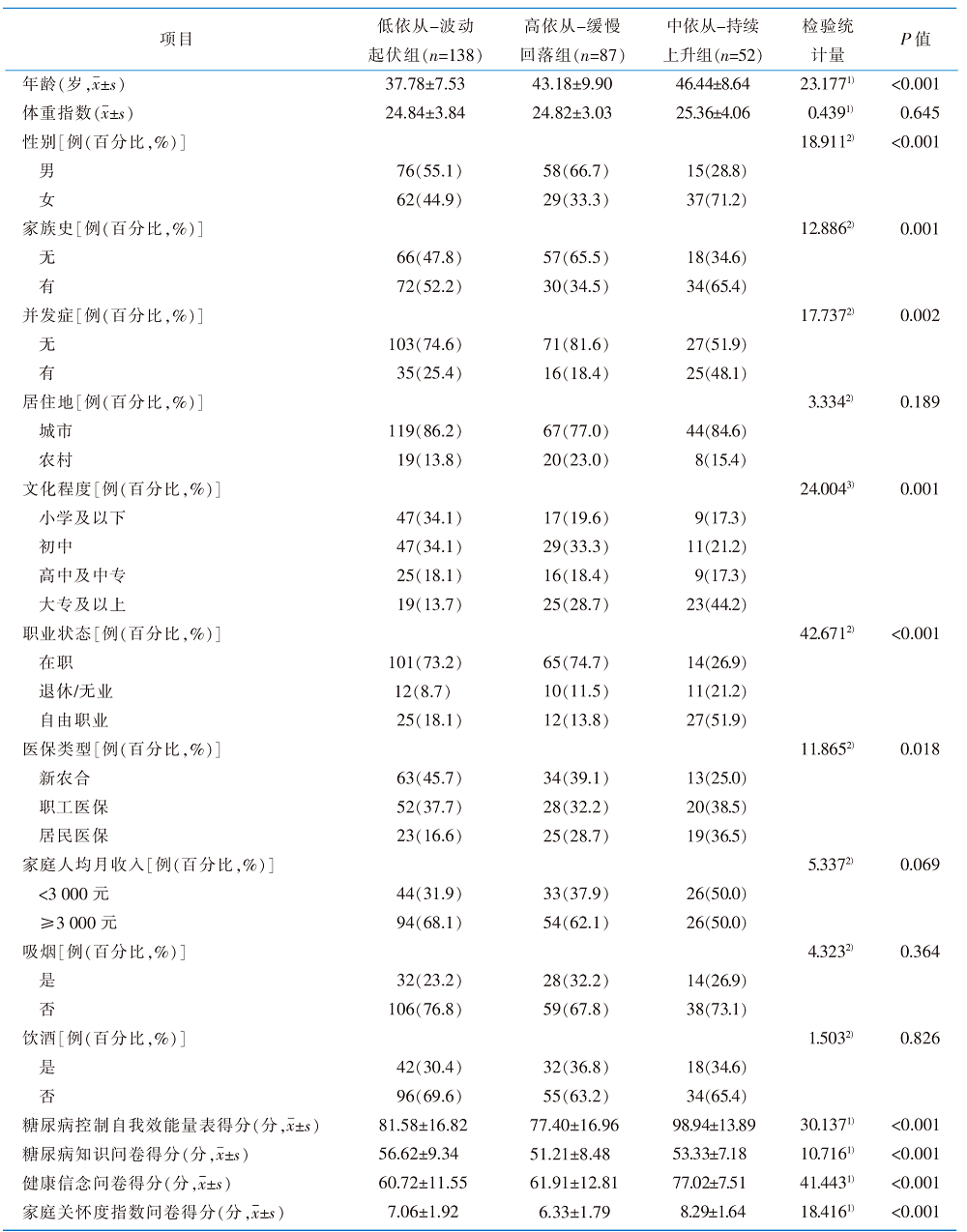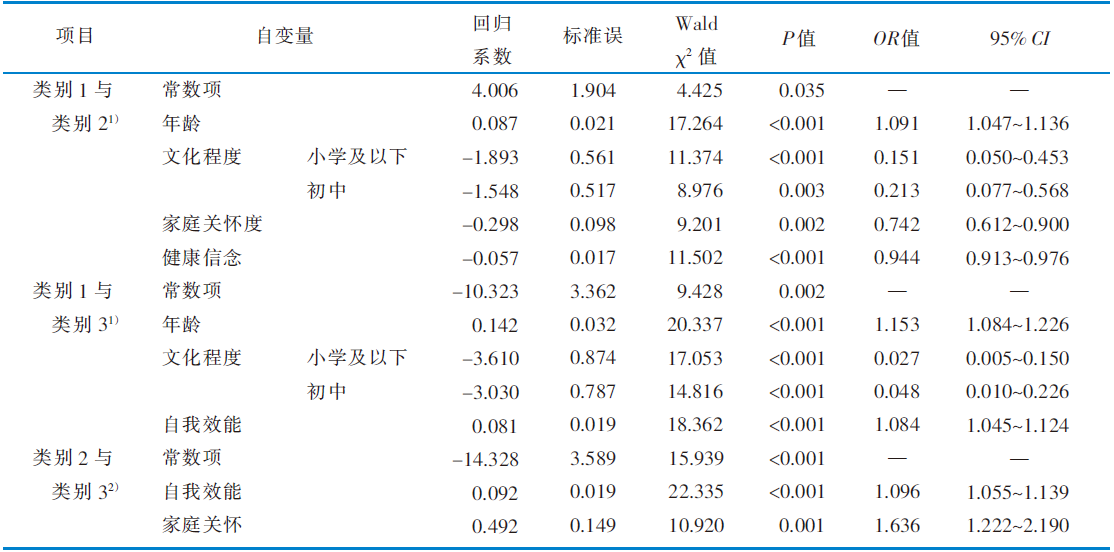


Chinese Journal of Nursing ›› 2024, Vol. 59 ›› Issue (13): 1592-1599.DOI: 10.3761/j.issn.0254-1769.2024.13.009
• Specialist Practice and Research • Previous Articles Next Articles
CAI Peixuan( ), LIANG Yiqing, WANG Jingjing, ZHAO Songqing, ZHANG Yi, CAO Songmei(
), LIANG Yiqing, WANG Jingjing, ZHAO Songqing, ZHANG Yi, CAO Songmei( )
)
Received:2023-09-01
Online:2024-07-10
Published:2024-07-02
蔡佩萱( ), 梁怡青, 王晶晶, 赵松青, 张怡, 曹松梅(
), 梁怡青, 王晶晶, 赵松青, 张怡, 曹松梅( )
)
通讯作者:
曹松梅,E-mail:作者简介:蔡佩萱:女,本科(硕士在读),护师,E-mail:Cpx016@163.com
基金资助:CAI Peixuan, LIANG Yiqing, WANG Jingjing, ZHAO Songqing, ZHANG Yi, CAO Songmei. Analysis of the trajectory of changes in dietary behavioral adherence in young and middle-aged patients with type 2 diabetes mellitus and the influencing factors[J]. Chinese Journal of Nursing, 2024, 59(13): 1592-1599.
蔡佩萱, 梁怡青, 王晶晶, 赵松青, 张怡, 曹松梅. 中青年2型糖尿病患者饮食行为依从性变化轨迹及影响因素分析[J]. 中华护理杂志, 2024, 59(13): 1592-1599.
Add to citation manager EndNote|Ris|BibTeX
URL: http://zh.zhhlzzs.com/EN/10.3761/j.issn.0254-1769.2024.13.009
 |
Table 2 Results of model fitting for analysis of potential categories of dietary behavior adherence in young and middle-aged patients with type 2 diabetes mellitus
 |

Figure 1 Trajectory of the development of potential categories of adherence to different dietary behaviors in young and middle-aged patients with type 2 diabetes mellitus
 |
Table 3 Results of a univariate analysis of potential categories of dietary behavioral adherence trajectories in young and middle-aged patients with type 2 diabetes mellitus(n=277)
 |
 |
Table 5 Results of multivariate logistic regression analysis of potential categories of dietary behavioral adherence trajectories in young and middle-aged patients with type 2 diabetes(n=277)
 |
| [1] | Sun H, Saeedi P, Karuranga S, et al. IDF Diabetes Atlas:global,regional and country-level diabetes prevalence estimates for 2021 and projections for 2045[J]. Diabetes Res Clin Pract, 2022, 183:109119. |
| [2] | 中华医学会糖尿病学分会. 中国2型糖尿病防治指南(2020年版)[J]. 国际内分泌代谢杂志, 2021, 41(5):482-548. |
| Chinese Diabetes Society. Guideline for the prevention and treatment of type 2 diabetes mellitus in China(2020 edition)[J]. Int J Endocrinol Metab, 2021, 41(5):482-548. | |
| [3] | Zhang Y, Luk AOY, Chow E, et al. High risk of conversion to diabetes in first-degree relatives of individuals with young-onset type 2 diabetes:a 12-year follow-up analysis[J]. Diabet Med, 2017, 34(12):1701-1709. |
| [4] | 张玲, 陈淑侠, 周玉森, 等. 基于自评-主观全面评定量表的个体化营养干预及膳食指导对初发2型糖尿病患者的干预效果[J]. 中国医药导报, 2023, 20(24):182-185. |
| Zhang L, Chen SX, Zhou YS, et al. Effect of individualized nutrition intervention and dietary guidance based on scored patient-generated subjective global assessment on patients with newly diagnosed type 2 diabetes mellitus[J]. Chin Med Her, 2023, 20(24):182-185. | |
| [5] | Dyson PA, Twenefour D, Breen C, et al. Diabetes UK evidence-based nutrition guidelines for the prevention and management of diabetes[J]. Diabet Med, 2018, 35(5):541-547. |
| [6] | 杨小平, 李翔, 许樟荣, 等. 2型糖尿病患者饮食治疗依从性与代谢控制关系的调查研究[J]. 中华护理杂志, 2010, 45(7):624-626. |
| Yang XP, Li X, Xu ZR, et al. Diet treatment compliance and metabolic control in Chinese patients with type 2 diabetes[J]. Chin J Nurs, 2010, 45(7):624-626. | |
| [7] | 张晓义, 顾海云, 黄燕华, 等. 跨理论模式干预对老年2型糖尿病患者饮食控制依从性的影响研究[J]. 中国全科医学, 2016, 19(34):4252-4257. |
| Zhang XY, Gu HY, Huang YH, et al. Effect of transtheoretical model on diet control compliance of the elderly with type 2 diabetes[J]. Chin Gen Pract, 2016, 19(34):4252-4257. | |
| [8] | 严佳丽, 裘慧颖, 贾芸, 等. 模拟体验并发症健康教育在中青年初发2型糖尿病患者中的应用[J]. 护理学报, 2021, 28(5):75-78. |
| Yan JL, Qiu HY, Jia Y, et al. Health education of simulated experiencecomplications in patients with type 2 diabetes melitus[J]. J Nurs(China), 2021, 28(5):75-78. | |
| [9] | Alberti KG, Zimmet PZ. Definition, diagnosis and classification of diabetes mellitus and its complications. Part 1:diagnosis and classification of diabetes mellitusprovisional report of a WHO consultation[J]. Diabet Med, 1998, 15(7):539-553. |
| [10] | 蒋知俭. 统计分析在医学课题中的应用[M]. 北京: 人民卫生出版社, 2008. |
| Jiang ZJ. Application of statistical analysis in medical subjects[M]. Beijing: People’s Medical Publishing House, 2008. | |
| [11] | Kim SY. Sample size requirements in single-and multiphase growth mixture models:a monte carlosimulation study[J]. Struct Equ Model Multidisc J, 2012, 19(3):457-476. |
| [12] | 赵秋利, 侯赛宁, 梁艳, 等. 2型糖尿病患者饮食行为依从性测评量表的开发及信效度检验[J]. 护理学杂志, 2017, 32(17):102-105. |
| Zhao QL, Hou SN, Liang Y, et al. Dietary Behavior Compliance Scale for Patients with Type 2 Diabetes Mellitus:development and validation[J]. J Nurs Sci, 2017, 32(17):102-105. | |
| [13] | Hurley AC, Shea CA. Self-efficacy:strategy for enhancing diabetes self-care[J]. Diabetes Educ, 1992, 18(2):146-150. |
| [14] | 王璟璇, 王瑞霞, 林秋菊. 门诊诊断初期非胰岛素依赖型糖尿病患者的自我照顾行为及其相关因素之探讨[J]. 护理杂志, 1998, 45(2):60-74. |
| Wang JX, Wang RX, Lin QJ. Study on self care behavior and related factors of non-insulin dependent diabetics at the early stage of outpatient diagnosis[J]. J Nurs (Taiwan,China), 1998, 45(2):60-74. | |
| [15] |
Fitzgerald JT, Funnell MM, Hess GE, et al. The reliability and validity of a brief diabetes knowledge test[J]. Diabetes Care, 1998, 21(5):706-710.
DOI PMID |
| [16] | 孙胜男. 糖尿病患者自我管理现状及影响因素的研究[D]. 北京: 中国协和医科大学, 2010. |
| Sun SN. Study on self-management status and influencing factors of diabetic patients[D]. Beijing: Peking Union Medical College, 2010. | |
| [17] |
Andreoli KG. Self-concept and health beliefs in compliant and noncompliant hypertensive patients[J]. Nurs Res, 1981, 30(6):323-328.
PMID |
| [18] | 陈亚梅. 再住院糖尿病患者依从性及其影响因素的调查研究[D]. 长沙: 中南大学, 2007. |
| Chen YM. Investigation and study on compliance and its influencing factors of hospitalized diabetic patients[D]. Changsha: Central South University, 2007. | |
| [19] | Smilkstein G. The family APGAR:a proposal for a family function test and its use by physicians[J]. J Fam Pract, 1978, 6(6):1231-1239. |
| [20] | 吕繁, 顾湲. 家庭APGAR问卷及其临床应用[J]. 国外医学(医院管理分册), 1995(2):56-59. |
| Lü F, Gu Y. Family APGAR questionnaire and its clinical application[J]. Foreign Med(Hosp Admin Subl Reg), 1995(2):56-59. | |
| [21] | Mclachlan GJ, Bean RW, Peel D. A mixture model-based app-roach to the clustering of microarray expression data[J]. Bioin-formatics, 2002, 18(3):413-422. |
| [22] | 李饶, 袁丽, 古艳, 等. 中青年2型糖尿病出院患者多形式随访的效果观察[J]. 护理学报, 2015(18):71-74. |
| Li R, Yuan L, Gu Y, et al. Effect of multiform follow-up on treatment compliance and glycemic control of discharged young and middle-aged patients with type 2 diabetes[J]. J Nurs(China), 2015, 22(18):71-74. | |
| [23] | Velázquez López L, Muñoz Torres AV, Medina Bravo PG, et al. Inadequate diabetes knowledge is associated with poor glycemia control in patients with type 2 diabetes[J]. Aten Primaria, 2023, 55(5):102604. |
| [24] | Wong S, Chen E, Smith H, et al. Assessing the mechanisms contributing to self-care behaviours in young and usual-onset diabetes[J]. Ann Fam Med, 2022, 20(20 Suppl 1):3101. |
| [25] | 张树光, 严杰, 孙玉娇, 等. 中青年2型糖尿病患者健康饮食行为及影响因素的研究[J]. 中华护理杂志, 2018, 53(7):816-821. |
| Zhang SG, Yan J, Sun YJ, et al. The stages and influencing factors of dietary behaviors in young and middle-aged patients with type 2 diabetes[J]. Chin J Nurs, 2018, 53(7):816-821. |
| [1] | SHEN Zhijia, CHEN Xinyu, QIAN Zhijie, YIN Limei. Behavioral characteristics of patients with recurrent hypoglycemia in the degeneracy of blood glucose management:a mixed-methods study [J]. Chinese Journal of Nursing, 2024, 59(9): 1043-1050. |
| [2] | WANG Limei, LI Lu, LI Yuxia, YU Peng, LUO Qian, ZHANG Chongni. The status and influencing factors of kinesiophobia in patients with diabetic peripheral neuropathic pain [J]. Chinese Journal of Nursing, 2024, 59(9): 1051-1056. |
| [3] | DING Huimin, DAI Limin, CAI Dongqing, YANG Qun. Potential profile analysis and influencing factors of self-management in prediabetic patients [J]. Chinese Journal of Nursing, 2024, 59(9): 1057-1064. |
| [4] | LIU Haiting, WANG Yongmei, ZHENG Beibei, CAI Lili, YE Linbin, WU Jiayun, NING Li, LI Yimin, CHEN Weixia. Development and reliability and validity test of a Self-Assessment Scale for Medication Literacy in Patients with Coronary Heart Disease Comorbidity Diabetes [J]. Chinese Journal of Nursing, 2024, 59(9): 1065-1071. |
| [5] | Allergy and Clinical Immunology Committee of Chinese Research Hospital Association, Allergy Care Group, Chinese Society of Allergology, Chinese Medical Association, Allergy Prevention and Control Committee of Chinese Preventive Medicine Association, (Writing Committee:WANG Qing, LIU Jun, ZHI Fan, WAN Wenjin, TIAN Fengying, HUO Xiaopeng, ZHOU Wenhua YANG Yongshi, WANG Tiantian, SUN Jinlü). Nursing expert consensus on subcutaneous injection for allergen-specific immunotherapy [J]. Chinese Journal of Nursing, 2024, 59(9): 1080-1083. |
| [6] | LI Qi, SU Qingqing, ZHANG Yaoyao, WANG Tiantian, LÜ Jing, LI Yake, LI Haiyan. A study on the trajectory and influencing factors of joint awareness in patients with total knee arthroplasty [J]. Chinese Journal of Nursing, 2024, 59(9): 1084-1090. |
| [7] | LIU Ya, LIU Xiaoqing, YANG Xuening, WANG Ping, LIU Xuekui, LUO Dan. Construction and validation of a risk predictive model for the bowel preparation failure in colonoscopy patients [J]. Chinese Journal of Nursing, 2024, 59(9): 1091-1098. |
| [8] | LI Xuqin, FENG Jiehui, HUANG Fangfang, YU Chao, LIANG Shiyu, WANG Xiao, LI Xufang, ZHU Han. Nursing care of a patient before operation with mechanical circulation-assisted bridging heart transplantation [J]. Chinese Journal of Nursing, 2024, 59(9): 1114-1117. |
| [9] | JIA Xiaojing, CHEN Yizhu, XU Zhiying, HE Xia, GENG Chao. Nursing care of a patient with acute myocardial infarction after double knee joint replacement due to alkaptonuria [J]. Chinese Journal of Nursing, 2024, 59(9): 1118-1121. |
| [10] | GU Peipei, ZENG Fei, LAN Meijuan, LIANG Jiangshuyuan, GUO Luyao, CAI Lingyun, ZHU Yan, GUO Ge. Influencing factors of frailty in lung transplant patients:a Meta-analysis [J]. Chinese Journal of Nursing, 2024, 59(9): 1122-1129. |
| [11] | CUI Yishuang, HE Xifei, WANG Zhaozhao, CHENG Jie, YANG Weimei, LU Lijuan. Shared decision making in acute coronary syndromes:a scoping review [J]. Chinese Journal of Nursing, 2024, 59(9): 1145-1152. |
| [12] | YU Liangmeng, YU Xiaoling, LI Jiamei, RUAN Xiaofen. Application progress of evidence mapping in nursing field [J]. Chinese Journal of Nursing, 2024, 59(8): 1021-1025. |
| [13] | GUO Miaomiao, YAN Tingting, XU Dandan, YUAN Ling. Development and application of a whole course management information system for breast cancer [J]. Chinese Journal of Nursing, 2024, 59(8): 901-908. |
| [14] | QIAO Wenbo, HOU Sijia, ZHU Keping, LI Yaqin, WU Siyuan, QI Ziyi, WANG Wei. Construction and application of a pelvic floor muscle training program for patients with radical prostatectomy [J]. Chinese Journal of Nursing, 2024, 59(8): 909-915. |
| [15] | LU Ping, WANG Xiaojie, GUO Hailing. Correlation between preoperative frailty and short-term postoperative complications in elderly breast cancer patients [J]. Chinese Journal of Nursing, 2024, 59(8): 916-921. |
| Viewed | ||||||
|
Full text |
|
|||||
|
Abstract |
|
|||||